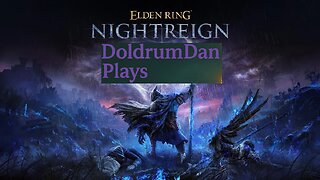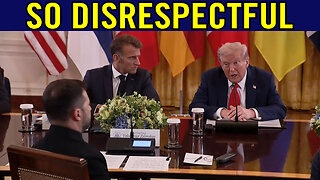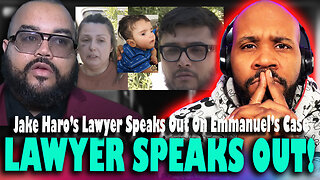Premium Only Content

mRNA is a class one carcinogen -- Today, on behalf of my professional friends and medical colleagues, I declare the mRNA vaccines to be class one carcinogens. mRNA is also a broad-spectrum mutagen. mRNA must be banned internationally. IAN BRIGHTHOPE
Today on behalf of my professional friends and medical colleagues, I declare the mRNA vaccines to be class one carcinogens.
mRNA is also a broad-spectrum mutagen.
mRNA must be banned internationally.
Wednesday the 17th. April, 2024
Ian Brighthope
Carcinogens.
Carcinogens are substances, organisms, or agents capable of causing cancer by altering the cellular, genetic, and epigenetic mechanisms within the body, leading to the transformation of normal cells into cancer cells[2][7]. These agents can be chemical substances, viruses, or even certain types of radiation therapies used to treat cancer[1]. Carcinogens may occur naturally in the environment, such as ultraviolet rays from the sun or certain viruses, or may be generated by human activities, such as automobile exhaust fumes and cigarette smoke[2].
The process of carcinogenicity, also known as carcinogenesis or tumour genesis, involves multiple stages where normal cells undergo a series of changes at the cellular, genetic, and epigenetic levels, resulting in abnormal cell division and the formation of cancer[16]. This process is characterized by:
1. Initiation: The first stage involves direct damage to the DNA inside of a cell by the carcinogen, leading to abnormal DNA that does not function properly. This damage can be caused by chemical substances, viruses, or radiation[1]
2. Promotion: Following DNA damage, the body attempts to repair the damaged DNA. However, sometimes the damage caused by the carcinogen interferes with the repair processes, leading to further abnormalities [16]
3. Progression: Over time, the accumulation of genetic and epigenetic alterations disrupts the normal balance between cell proliferation and programmed cell death (apoptosis), resulting in uncontrolled cell division and the evolution of cancerous cells[16].
Carcinogens do not necessarily cause cancer in every case or under all circumstances. Factors such as the amount and duration of exposure, the individual's genetic makeup, and exposure to other environmental factors play a significant role in determining whether a person exposed to a carcinogen will ultimately develop cancer[1][5]. Moreover, not all mutations caused by carcinogens lead to cancer; only certain mutations in specific genes that regulate cell growth, apoptosis, and DNA repair may result in uncontrolled cell proliferation and cancer[16].
Carcinogens can be classified based on their mode of action into genotoxic and non-genotoxic carcinogens. Genotoxic carcinogens directly interact with DNA and/or the cellular apparatus, affecting the integrity of the genome, whereas non-genotoxic carcinogens exert their effects through mechanisms that do not involve direct DNA damage[12]. The International Agency for Research on Cancer (IARC) classifies carcinogens into categories based on the strength of evidence regarding their carcinogenicity to humans, ranging from "carcinogenic to humans" (Group 1) to "not classifiable as to its carcinogenicity to humans" (Group 3)[7].
In summary, carcinogens are agents that can cause cancer through a multistep process involving the alteration of cellular and genetic mechanisms, leading to the transformation of normal cells into cancer cells. The carcinogenic potential of a substance depends on various factors, including the type of exposure, genetic predispositions, and the presence of other risk factors.
From the International Agency for Research on Cancer (IARC)
The IARC Monographs identify factors that can increase the risk of human cancer, including lifestyle factors.5-7 Interdisciplinary working groups of expert scientists review the published studies and evaluate the weight of the evidence that an agent can increase risk of cancer. Agents are then categorised as carcinogenic, probably or possibly carcinogenic, or not carcinogenic to humans, based on the strength of the evidence.
The evidence relevant to carcinogenicity of agents from studies in humans is classified into four categories by the IARC Working Group:90
Sufficient evidence of carcinogenicity (highest IARC classification for carcinogenicity): The Working Group considers that a causal relationship has been established between exposure to the agent and human cancer. That is, a positive relationship has been observed between the exposure and cancer in studies in which chance, bias and confounding could be ruled out with reasonable confidence.
Limited evidence of carcinogenicity (positive association): A positive association has been observed between exposure to the agent and cancer for which a causal interpretation is considered by the Working Group to be credible, but chance, bias or confounding could not be ruled out with reasonable confidence.
Inadequate evidence of carcinogenicity: The available studies are of insufficient quality, consistency or statistical power to permit a conclusion regarding the presence or absence of a causal association between exposure and cancer, or no data on cancer in humans are available.
Evidence suggesting lack of carcinogenicity: There are several adequate studies covering the full range of levels of exposure that humans are known to encounter, which are mutually consistent in not showing a positive association between exposure to the agent and any studied cancer at any observed level of exposure.
The IARC Working Group also considers the body of evidence as a whole, in order to reach an overall evaluation of the carcinogenicity of the agent to humans. The categorisation of an agent into one of the following four groups is a matter of scientific judgement that reflects the strength of the evidence derived from studies in humans and in experimental animals and from mechanistic and other relevant data:90
Group 1 carcinogen: The agent is carcinogenic to humans. This category is used when there is sufficient evidence of carcinogenicity in humans.
Group 2: Group 2A (probably carcinogenic to humans) or Group 2B (possibly carcinogenic to humans). This category includes agents for which, at one extreme, the degree of evidence of carcinogenicity in humans is almost sufficient, as well as those for which, at the other extreme, there are no human data but for which there is evidence of carcinogenicity in experimental animals.
Group 3: The agent is not classifiable as to its carcinogenicity to humans. This category is used most commonly for agents for which the evidence of carcinogenicity is inadequate in humans and inadequate or limited in experimental animals.
Group 4: The agent is probably not carcinogenic to humans. This category is used for agents for which there is evidence suggesting lack of carcinogenicity in humans and in experimental animals.
Note – this position statement does not include agents with inadequate evidence of carcinogenicity or evidence suggesting lack of carcinogenicity, or agents which have been categorised lower than Group 1 by the IARC Working Group.
World Cancer Research Fund (WCRF) and American Institute for Cancer Research (AICR)
The 2007 WCRF and AICR Food, Nutrition, Physical Activity and the Prevention of Cancer: a Global Perspective report and subsequent tumour-specific updates are based on systematic reviews of the scientific literature for food, nutrition and physical activity.8-15 An expert Panel judged and graded the evidence as convincing, probable, limited or unlikely to affect cancer risk, and developed recommendations to reduce the incidence of cancer.
The WCRF and AICR Panel made judgements on causation of disease based on assessment of independently conducted systematic reviews of the literature. The WCRF and AICR Panel graded the evidence into five categories:8
Convincing evidence: This is the highest level attributed by the WCRF & AICR Panel, for evidence strong enough to support a judgement of a convincing causal relationship, which justifies goals and recommendations designed to reduce the incidence of cancer.
Probable evidence: This is the second-highest level attributed by the WCRF & AICR Panel, for evidence strong enough to support a judgement of a probable causal relationship, which would generally justify goals and recommendations designed to reduce the incidence of cancer.
Limited – suggestive evidence: These criteria are for evidence that is too limited to permit a probable or convincing causal judgement, but where there is evidence suggestive of a direction of effect.
Limited – no conclusion: Evidence is so limited that no firm conclusion can be made. This category is intended to allow any exposure for which there are sufficient data to warrant Panel consideration, but where insufficient evidence exists to permit a more definitive grading.
Substantial effect on risk unlikely: Evidence is strong enough to support a judgement that a particular food, nutrition, or physical activity exposure is unlikely to have a substantial causal relation to a cancer outcome.
Note – this position statement does not include agents where the Panel has judged the evidence to be limited – no conclusion or substantial effect on risk is unlikely.
COMMENT:
Decide for yourselves the level of carcinogenicity that characterises mRNA.
Professor Ian Brighthope
Click for the full paper, in the document HERE: https://ianbrighthope.substack.com/p/mrna-is-a-class-one-carcinogen?publication_id=1749153&post_id=143662405&isFreemail=true&r=b8lla&triedRedirect=true
-
 25:57
25:57
DeVory Darkins
1 day ago $12.57 earnedNewsom suffers HUMILIATING SETBACK after FATAL Accident as Trump leads HISTORIC meeting
30.2K127 -
 LIVE
LIVE
FyrBorne
11 hours ago🔴Warzone M&K Sniping: First Impressions of Black Ops 7 Reveal
272 watching -
 8:16
8:16
MattMorseTV
17 hours ago $8.42 earnedTrump’s name just got CLEARED.
70.8K75 -
 2:01:55
2:01:55
MG Show
21 hours agoPresident Trump Multilateral Meeting with European Leaders; Trump Outlines Putin Zelenskyy Meeting
25K19 -
 LIVE
LIVE
DoldrumDan
2 hours agoCHALLENGE RUNNER BOUT DONE WITH ELDEN RING NIGHTREIGN STORY MODE HUGE GAMING
79 watching -
 10:59
10:59
itsSeanDaniel
1 day agoEuropean Leaders INSTANTLY REGRET Disrespecting Trump
19.6K16 -
 16:43
16:43
GritsGG
17 hours agoThey Buffed This AR & It Slaps! Warzone Loadout!
18.1K1 -
 2:05:30
2:05:30
Side Scrollers Podcast
21 hours agoEveryone Hates MrBeast + FBI Spends $140k on Pokemon + All Todays News | Side Scrollers Live
114K12 -
 11:06
11:06
The Pascal Show
15 hours ago $1.47 earned'THEY'RE GETTING DEATH THREATS!' Jake Haro's Lawyer Breaks Silence On Emmanuel Haro's Disappearance!
18.6K2 -
 LIVE
LIVE
Lofi Girl
2 years agoSynthwave Radio 🌌 - beats to chill/game to
317 watching